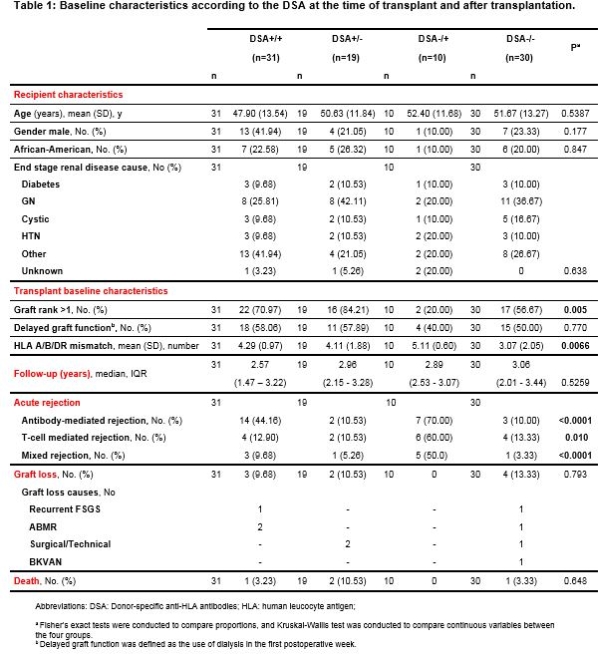Impact of De Novo DSA (DnDSA) on Outcomes in HLA-Sensitized (HS) Patients Transplanted after IVIG + Rituximab Desensitization (DES)
1Kidney Transplant, Cedars-Sinai Medical Center, LA, CA
2Paris Translational Research Center for Organ Transplantation, Necker Hospital, Paris, France.
Meeting: 2018 American Transplant Congress
Abstract number: A121
Keywords: B cells, Highly-sensitized, HLA antibodies, IVIG
Session Information
Session Name: Poster Session A: Kidney Acute Antibody Mediated Rejection
Session Type: Poster Session
Date: Saturday, June 2, 2018
Session Time: 5:30pm-7:30pm
 Presentation Time: 5:30pm-7:30pm
Presentation Time: 5:30pm-7:30pm
Location: Hall 4EF
Introduction: Highly-HLA sensitized patients (HS) with donor specific antibodies (DSA) at transplant are at risk for Type 1 ABMR. However, the incidence of Type 2 ABMR HS patients who developed dnDSA after transplant is unclear. Here we examine the risk for ABMR in HS patients (>80% PRA) after DES who were DSA+ vs. DSA- at transplant. In addition, we examined the incidence & impact of dnDSA development and compared with those who remained dnDSA-. Patients & Methods: From January 2013-October 2016, 90 HS patients received kidney transplantation after DES with IVIG +rituximab ±PLEX ±Tocilizumab (TCZ). All received induction with alemtuzumab & maintained on tac/mmf/pred. Patients were stratified based on their DSA status at time of transplant & post-transplant. Outcomes including rate of ABMR, patient & graft survival & eGFR were recorded up to 36M. Results: Ninety HS patients {GIA:DSA+/+ (n= 31), GIB:DSA+/- (n= 19), GIIA:DSA-/+ (n=10) and GIIB:DSA-/- (n=30)} received transplants. Table 1 shows demographic characteristics. Briefly, previous transplants among the groups were as follows: GIB>GIA>GIIB>GIIA respectively (p=0.005). Freedom from ABMR was 55% (GIA), 89.5% (GIB), 30% (GIIA) and 90% (GIIB) (p<0.0001). Graft loss from ABMR was seen in 2 patients (14%) in GIA, but no graft loss was seen in patients with dnDSA (GIIA). Ten patients (GIIA, 25%) developed dnDSA (2500-5000MFI) range from 12d-270d (20% CI, 50% CII, & 30% CI & CII). Of these, ABMR occurred in 70% vs. 10% of dnDSA-. Treatment of ABMR included Plex/IVIG/Ritux (43%) or Plex/IVIG/TCZ (57%). Despite higher ABMR rates after development of dnDSA in GIIA, no significant differences in graft survival, patient survival & eGFR were seen among the groups. Conclusions: After DES, DSA+ or DSA- at time of transplant has no impact on incidence of ABMR or graft loss at 36M. DnDSA development was associated with a significant risk for Type 2 ABMR. Thus, frequent monitoring of HS patients for dnDSA is essential.
CITATION INFORMATION: Vo A., Aubert O., Edmund H., Peng A., Najjar R., Supreet S., Choi J., Lim K., Jordan S. Impact of De Novo DSA (DnDSA) on Outcomes in HLA-Sensitized (HS) Patients Transplanted after IVIG + Rituximab Desensitization (DES) Am J Transplant. 2017;17 (suppl 3).
To cite this abstract in AMA style:
Vo A, Aubert O, Edmund H, Peng A, Najjar R, Supreet S, Choi J, Lim K, Jordan S. Impact of De Novo DSA (DnDSA) on Outcomes in HLA-Sensitized (HS) Patients Transplanted after IVIG + Rituximab Desensitization (DES) [abstract]. https://atcmeetingabstracts.com/abstract/impact-of-de-novo-dsa-dndsa-on-outcomes-in-hla-sensitized-hs-patients-transplanted-after-ivig-rituximab-desensitization-des/. Accessed December 15, 2025.« Back to 2018 American Transplant Congress
